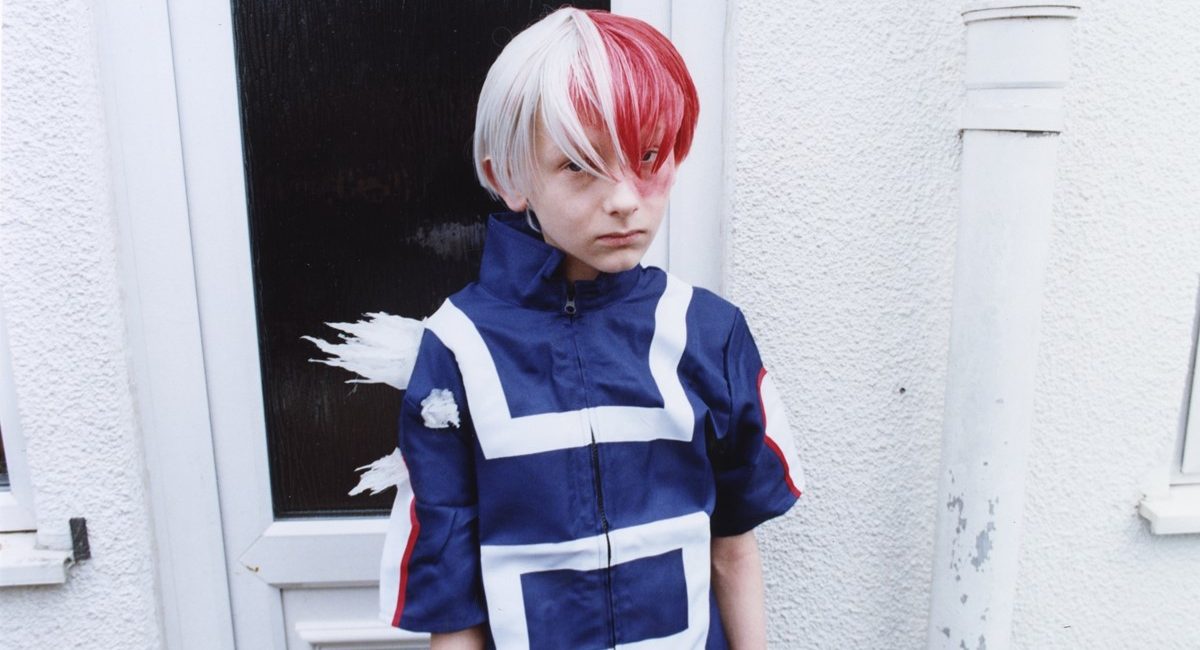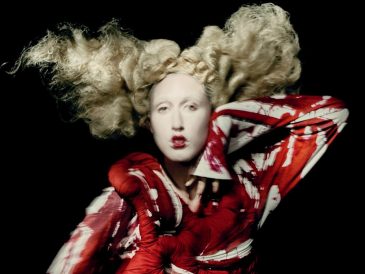Lead ImageCosplay by Luca WardPhotography by Luca Ward, Casting by Luca Ward and Coco Kwu
The challenges faced by emerging fashion communicators are varied. In a dystopian landscape of TikTok hauls, an impending AI takeover, and stormy times in war and politics, what’s the point of fashion, and why should it even matter? It’s a question probed and prodded by many of the students studying under the Fashion Communication pathway at Central Saint Martins, who hope to liberate conversations around fashion from its ‘superficial’ epithet with meaningful projects that pack a punch in their scrutiny of identity, new-era technology and cultural divisions.
It’s a level of critical reflection that comes deep-rooted to the pathway’s old-school approach to tuition, which has birthed some major industry players like Ib Kamara, Alexander Fury, Gareth Wrighton, Campbell Addy, Hanna Moon, Rachel Fleminger Hudson and many more, who have each formed radical new ways of communicating.
As a new batch of students graduate from the pathway, we speak with ten young image-makers, journalists and artists, who, through their deeply personal work, challenge the status quo of what it means to be a fashion communicator in the 21st century.
“theirs magazine is a celebration of beauty beyond gender, where fashion and art intersect to challenge traditional norms. It exists as a testament to support and creativity within this community, where traditional notions of gendered fashion are seamlessly blurred.
“My personal journey in dressing has definitely influenced my work. I’ve never understood gendered clothing. Growing up in Helsinki, Finland, my lovely mother used to ask me whether the clothes I wore were for men or women. But I don’t really see a specific gender in clothing or heels. Garments might appear to be associated with a certain gender, but in reality, they aren’t confined to any. I’ve always felt disconnected from traditional ways of dress, and the publication aims to reflect that ethos.“
“This photo series explores the fascination of becoming somebody else. The project began by investigating how I would lie about myself as a child. I developed a fixation with characters that enabled me to escape my reality. As a young boy, this manifested in superheroes – those who lived an alternative life that was perhaps truer than their ‘normal’ lives. This series captures the different stages of escapism – the initial moment children become these characters and how they can grow to become a large part of them, which they then carry into adulthood. Doing this series, I have come to realise how important these characters have been (and still are) for me and who I am today.
“My work is a documentation of my curiosity, and I find it helpful to use personal experiences from my childhood and early teens to fuel my work. When I am inspired by something that has resonated with me, I feel my work doesn’t have a definitive start or end point. I find myself switching between projects constantly as my interests diverge, which manifests into small series that can be encompassed into a larger story, made up of numerous people.”
“Since moving from South Korea to London, I’ve realised just how important the relationships surrounding me are. These days most of my interactions happen digitally. Even though we can express emotions through texts or emojis, it doesn’t feel the same as real, face-to-face communication. It’s made me appreciate the true value of human connection and reminded me of how important it is not to lose touch with genuine human interaction. My art has become a form of ongoing therapy; it’s a way for me to slow down and explore the depths of my emotions. After beginning therapy this year, I learned to be more honest with myself about what I truly crave: love and comfort, not just in words, but in the warmth of genuine human connection.
“My final major project is the performative installation that challenges communication norms in the digital era, prioritising tangible interaction for deeper human connections. Using an interactive sound body suit, it delves into emotions. I want my work to be like a comforting, stuffed toy, inviting people to pause, embrace its warmth, and reflect on a time when they felt truly at ease.”
“Piss is the quarterly(ish) rag all about leaving a puddle in the white cube of mainstream American culture. In each themed issue, Piss looks to the past and the future to mark our territory in the chaotic present. Issue one is called American Revolution and captures the psychotic Americana I dream of when I’m away from home. Growing up in the US, I became interested in old gay newspapers which were printed on the paper-ends of regular broadsheets by gays and their friends in publishing. It was about paying homage to papers like Gay!, Fag Rag and Gay Sunshine.
“[With Piss], I wanted to be able to filter out people who weren’t open to looking at queer bodies, making fun of Americana and generally getting past a certain frigidity that Gen-Z can have about perspectives which differ from their own. There’s so much bullshit out there that we have become non-reactive to a lot of stuff. I wanted to offer a mix of graphic gay content with writing about how people live delusional lives online, all at a broadsheet size, to get in people’s faces.”
“I’m a relatively introverted person. I often feel alienated by my surroundings, like when a lens can’t focus. I have been thinking about what makes an image into a fashion image; it’s not just styling – clothes themselves have no meaning – but I treasure the feelings and stories I experience when I wear them. They can link to certain memories, which is what I want to explore with fashion images.
“Connection Failed is a photo series that records the unexpected detachment from reality at certain moments. Although I photographed others, and seemed to be recording others’ stories, they are all related to my memories, such as how I always talked to myself, how I had to be alone at home when I was a child, and my relationship with my grandmother. I hope that my images resonate because although all our experiences are different, these emotions can be shared.”
“Sh-It Girl is a filthy celebration of the anti-‘it’-girl. It’s an ode to a new generation of chronically online young women and explores the confusing digital feminist landscape as we know it today. Through a plethora of female talent, we usher in a new wave of tastemakers and themes that matter to Gen-Z women, away from the ‘clean girl’ cult to revel in the ultimate Sh-It Girl lifestyle.
“It is overwhelming to be a young woman online. Are you a dirty girl or a clean girl? Are you aware that by wearing that you are defending the classic Lolita aesthetic and all the issues that follow? We are just making shit up as we go along. There feels like no safe space for young women to be themselves online for fear they are lumped under the next pithily named TikTok-core. ‘Let women enjoy things’ or ‘let her speak’ is a staple comment I see these days. So why not create a safe space away from the online sphere where we can speak?”
“Sterling Wongchoi is a 300-plus page book named after a racehorse in Hong Kong. Featuring curated visual and literary commentary, it investigates the linguistic and cultural absurdities through the cross-pollination of East and West throughout Hong Kong’s visual culture, as it remains entangled with the city’s lingering colonial past.
“This book plays with your expectations, challenging what you would expect to see in a magazine or a photo book format. I analysed how I consume the material I’m studying, every country I’ve been in, how I communicate with my family, the music I listen to, and how everything I deem ‘banal’ ultimately frames who I am. I grew up in Hong Kong, moved to Arizona, then Grimsby, then finally London. Every move has left me with an insight into new cultures, and that’s encouraged me to become not only more sensitive and acute to the differences but also more open to discussing the similarities in polarising situations.”
“Viva La Children is the ultimate all-women bible, created by girls, for everyone. From window-shopping and giving birth to marching for Palestinian lives and climate change, the magazine taps into a network of girls, whose insight, attitude and compassion are matched by their distinctive voices. You can read personal essays, advice columns and op-eds relating to style, sex, friends, fashion, health and beauty – everything a girl thinks, dreams and most importantly, cares about.
“In the first edition, we extol the virtues of shopping for a serotonin boost, languid Hinge confessions and the joyously merry and muddy escapades of first girl holidays. We also hang out with the costume designers of Sofia Coppola and Gregg Araki’s films, Stacey Battat and Cathy Cooper, about fashioning girlhood on screen. Working alongside Bethany Griffiths, my creative partner in crime, being raised by a single mother, and having such strong women around me has influenced my work. I see Viva La Children as the Shocking Pink, Spare Rib and Jackie magazine of the modern day; anthologising the sharp, smart and sensible writing of women and young girls.”
“Steam Steam Day Up! is a documentary about the life of second-generation British-Chinese dry cleaner, Tony Chung. As the owner of a dry-cleaning and lifestyle store called The Steam Room, with a clientele ranging from local to independent fashion brands like Simone Rocha and Roksanda, the film captures how ‘ordinary’ and overlooked people like Tony are irreplaceable parts of fashion’s life cycle. Dedicated to the international East and Southeast Asian diaspora, the project embraces heritage in the post-pandemic world.
“Growing up as a second-generation Chinese immigrant in the West has encouraged me to focus on my own roots. I wanted to use my final project as an opportunity to spotlight Asian creativity and inspire our community to speak up. With little coverage of Chinese immigration history or the general Asian experience in Western mainstream media, I think it’s important to speak about individual experiences, as it reflects wider socio-political issues happening now. Having conversations about this topic is the first step towards a bigger change.”
“In this untitled project, I am exploring the concept of techno-animism and the autonomy of our digital identities. Derived from ideas of Shintoist ideology, animism is the idea that we imbue objects, places, and entities with their own life and significance. This is akin to how we give life to our own digital identities. I wish to examine the connection of how these systems we interact with develop an identity of their own. This piece attempts to visualise the sheer amount of data we unknowingly proliferate through our use of technology, and how technological structures appropriate this data.
“By sharing content on the internet and social media, we sign away the rights to our data to these institutions. The data is harvested and used to train a variety of AI-based models. Essentially, a part of our souls becomes the information that makes up these systems, making them symbolic of our collective consciousness. I have created a portrait of my subjects using their data as a way to encapsulate these ideas. The imagery I have used has been derived from various sources including digital photography, sourced images, AI-generated footage, and abstracted EXIF data taken from the imagery I have created.”





